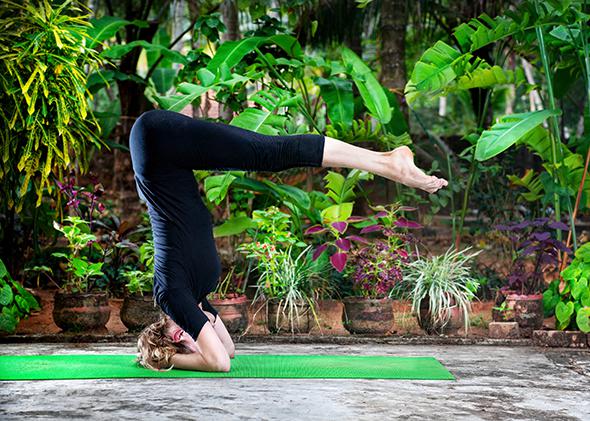The last thing I want to do during my period is stand on my head. So if a yoga teacher says to skip inversions like headstand, handstand, or shoulderstand if I’m “on my cycle,” I usually listen, happy for the excuse to spend a few extra minutes lying motionless on the floor. But after nearly 10 years of yoga classes, and countless instructors telling me not to invert if I’m menstruating, I realized I’d never heard a teacher explain why. Is there a legitimate medical reason to keep your feet on the ground during your period? Or is this oft-repeated advice as unreasonable as the wandering womb?
Conversations with yoga teachers yield two main reasons for staying right-side up while menstruating: apana and endometriosis. According to yogic tradition, your body’s energy during your period is apana, or flowing downward, and it’s better not to mess with that by swinging your feet over your head. Fair enough. But screwed-up apana isn’t a medical condition. Endometriosis is.
Endometriosis is a condition in which cells resembling those in your uterine lining (the stuff you shed during your period) start growing outside your uterus, creating lesions that often lead to excruciating pain and sometimes even infertility. Endometriosis lesions can pop up pretty much anywhere in the abdomen, but some locations are more common than others, such as on the outside of the ovaries, the intestines, and the bladder. More rarely, lesions can appear on the diaphragm and even the lungs.
So how do uterine lining cells end up growing outside the uterus in the first place? No one really knows, but one longstanding theory is “retrograde menstruation”—basically, when your period flows backward out of your fallopian tubes and into your abdomen, instead of out of your vagina. After floating around for a while, those rogue uterine lining cells latch onto other organs and grow into the painful lesions of endometriosis.
This is where the idea of not standing on your head comes in. In headstand or other inversions, the thinking goes, gravity will pull your menstrual flow away from your vagina and toward your fallopian tubes, increasing the risk of retrograde menstruation and, therefore, endometriosis. If you want to keep your period flowing down and out of your body, you don’t want to physically turn your uterus upside down. Right?
Wrong. In the first place, retrograde menstruation is far from being the conclusive cause of endometriosis. Lesions have been observed in places where rogue menstrual blood definitely cannot reach, like the skin, the brain, and even the eye. Very occasionally, the disease shows up in men who have received estrogen treatments after prostate surgery. Retrograde menstruation can’t explain those cases, so even doctors who believe it plays a role in the more common types of endometriosis know there has to be more to the story.
Then there’s the fact that back in 1984, a group of doctors decided to see just how common retrograde menstruation was. They took samples of the fluid surrounding women’s pelvic organs while they were on their periods and found that a whopping 90 percent of the samples contained menstrual blood. That means almost all women who get periods experience retrograde menstruation. But only about 10 percent of women of reproductive age develop endometriosis.
The best explanation for the discrepancy has to do with the immune system, says Lone Hummelshoj, the Secretary General of the World Endometriosis Society. In most women, the immune system’s killer cells will vacuum up any stray bits of uterine lining hanging out in the abdomen long before they can cause problems. That mechanism might not be working in women who develop endometriosis, Hummelshoj says. So if you’re among the majority of women who will spend their lives endometriosis-free, your body will take care of the exceedingly normal process of retrograde menstruation on its own. You can spend hours standing on your head during your period and it won’t make a difference.
What about women who already have endometriosis, or those who have a family history of the disease? Could period inversions be dangerous for them? No way, says Robert Taylor, a reproductive biologist at the Wake Forest School of Medicine. Menstrual blood doesn’t “fall out of the uterus” due to gravity, he says. It’s pushed out by uterine contractions. Because turning upside-down has no effect on those contractions, inversions won’t change the direction of your flow or increase the amount of retrograde menstruation you experience, he says. In other words, standing on your head, hands, or shoulders is no riskier than standing on your feet, sitting on your butt, lying on your back, or any other position you want to assume during your period.
Of course, none of this means that you have to invert while you are menstruating (or any other time). Not feeling like doing a headstand is a great reason not to do a headstand, no matter where you are in your cycle. So invert away, you energetic menstruators! I’ll be over here, armed with a lot more knowledge but still lying motionless on the floor.
